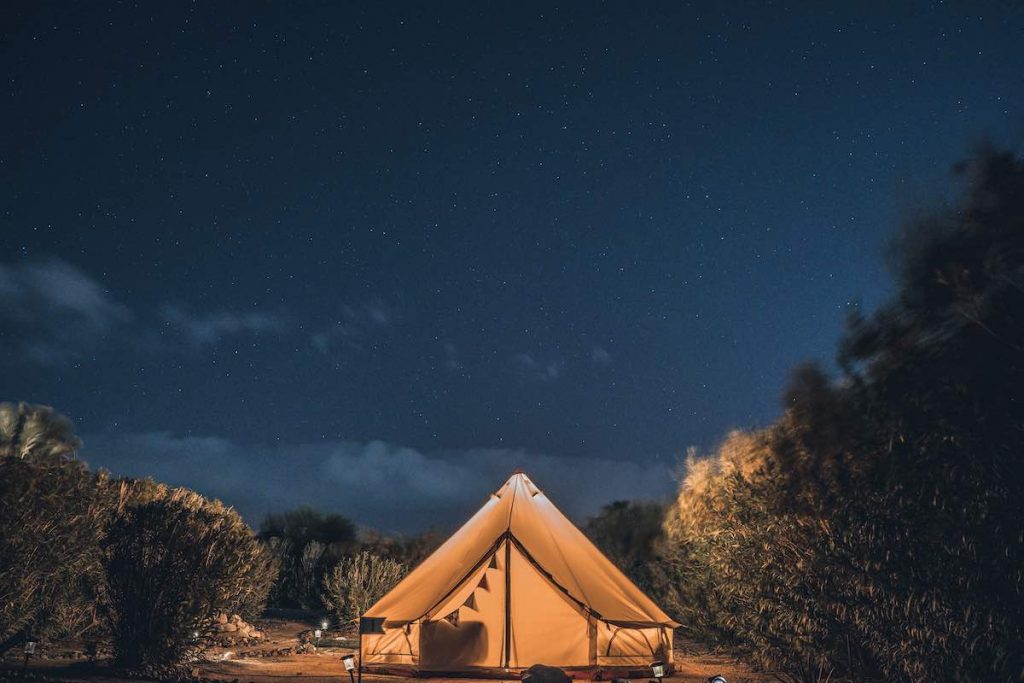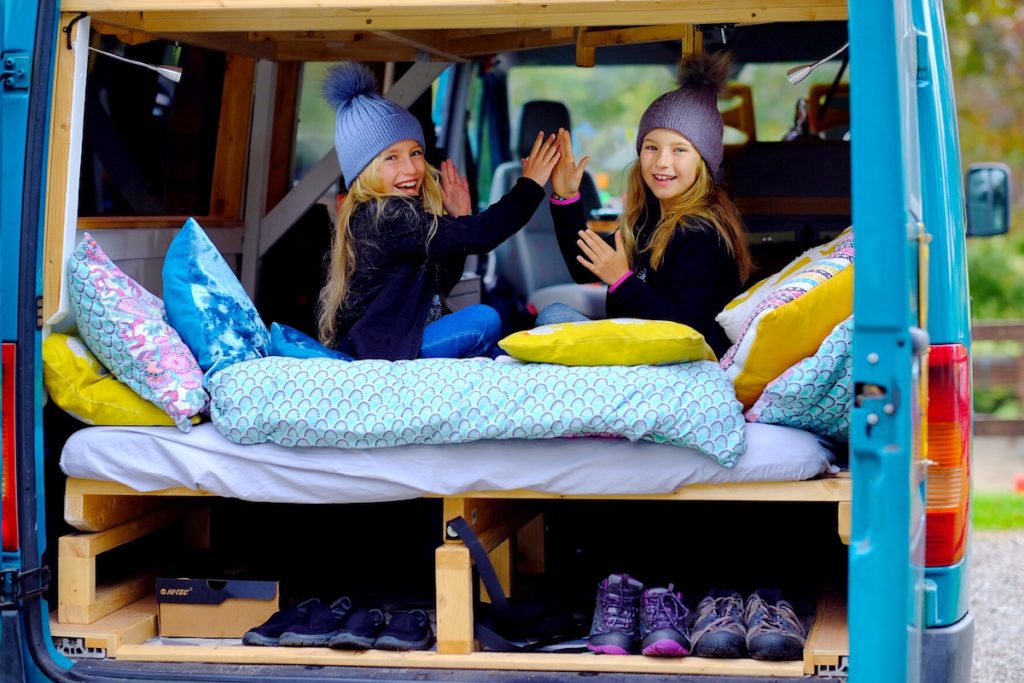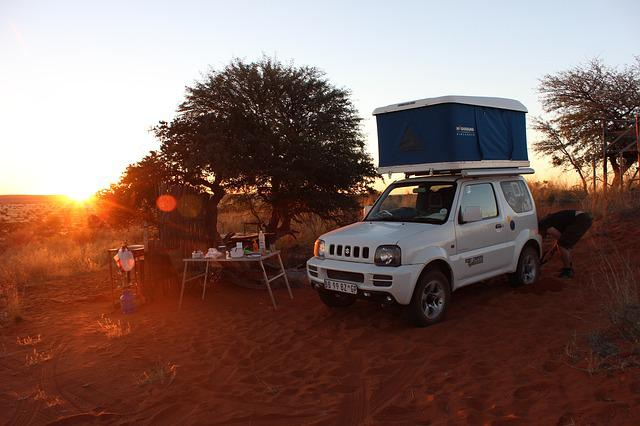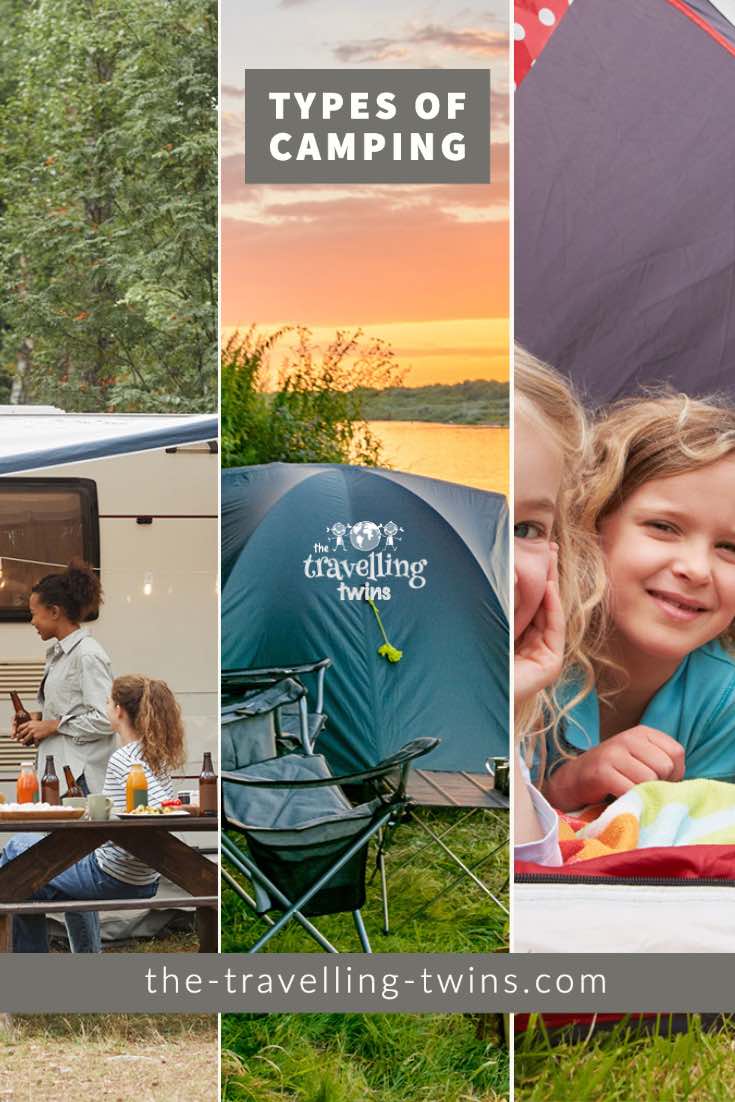Camping is a great way to escape city life’s hustle and bustle. It’s a chance to breathe fresh air, enjoy the outdoors and relax with family and friends. But there are many different types of camping, depending on what you’re looking for. You can go car camping, backpacking, canoe camping, or even hike-in camping.
No matter what your style, there’s a perfect type of camping for you! And a camping adventure is a perfect time to try some of the fun camping games and great way to enjoy the great outdoors
And of course, Heading for outdoor adventure, don’t forget these camping essentials – we have a hiking list ready for you.

What to consider when choosing a camping style
When choosing a camping style, there are a few things you’ll want to consider:
What type of terrain do you want to camp on?
Some camping styles, like car camping, are limited to certain types of terrain. Other styles, like backpacking, allow you to camp anywhere there is an open space.
How much gear do you want to carry with you?
If you’re car camping, you can bring more gear with you than if you’re backpacking. Canoe camping and hike-in camping require even less gear, as you can often just bring what you need strapped to your back.
How far do you want to travel each day?
If you’re car camping, you don’t have to travel very far each day. Will you be moving your camping spot every day or staying in one place for longer?
What’s your budget?
Car camping can be the most affordable option, glamping the easiest one but same time the most expensive one.
Once you’ve answered these questions, you’ll be able to choose the perfect camping type for you!

Glamping – Glamorous camping
This camping style was invented recently, and it’s best for first-time campers or for families. Here you don’t have to worry about packing all the gear. Almost everything is ready for you. You just need to show up.
Glamping combines the best of camping and luxury hotels, giving you all the benefits of nature with all the amenities of a high-end resort. Glamping is perfect for those who want to enjoy the great outdoors but don’t want to rough it.

There are many different types of glamping, so you can find one that fits your needs. If you want a luxurious experience, opt for a glamping site with yurts or cabins. If you’re looking for something more adventurous, try camping in a teepee or wagon. No matter what your style, glamping is a great way to enjoy nature without sacrificing any comfort!
Developed Campground Camping
This type of camping is perfect for those who want the amenities of home while they’re camping. Developed camping grounds have flush toilets, showers, and sometimes even laundry facilities. This type of camping is perfect for families or those who want a little bit of luxury while they’re away from home.
Developed campgrounds can be found in all sorts of locations, from national parks to state parks. Be sure to research the amenities of each campground before you book a site. And remember, even though you have access to showers and flush toilets, you still need to pack out all your trash!
RV Camping
Recreational vehicle Camping (RV camping) is the perfect option for those who want the convenience of camping with all the comforts of home. An RV is a self-contained vehicle that includes a kitchen, bathroom, and sleeping area, so you can travel anywhere and camp without having to set up a tent or use a portable stove.

RV camping is a great option for families, as it allows everyone to have their own space. It’s also a great way to see the country, as you can travel to different campsites each night. And since RVs come in all sizes, you can find one that fits your needs and budget.
If you’re interested in RV camping, be sure to do your research first. There are many different types of RVs on the market, so you need to find one that’s right for you. And be sure to check out the campsites in your area – not all of them are equipped to handle RVs.
Backyard Camping
Backyard camping is a great way to get started camping without having to travel too far. Backyard campers set up their tents in their own backyard, so they can enjoy the convenience of being close to home. This type of camping is perfect for those who want to try camping for the first time or for those who want to let their kids camp on their own.
Backyard camping can be as simple or as complicated as you want it to be. You can just set up a tent in your yard, or you can create an entire campsite with a firepit and picnic table. And if you have kids, backyard tent camping is a great way for them to learn about camping and nature.
Backyard camping is a perfect opportunity to test the star gazing tent or any tent before you will do the wild camping (dispersed camping) outside the designated campground.
Car Camping
The car camping trip is perfect for those who want to explore the great outdoors without having to hike or paddle to their campsite. Car campers travel with all their gear in their car, so they can access remote areas that are inaccessible by foot or bicycle. This type of camping is perfect for those who want to see as much as possible on their trip.

Car camping can be challenging, as you need to be able to pack everything you need for a comfortable trip. But with a little planning, it’s easy to pack everything you need for a comfortable trip. And since you’ll have access to remote areas, you can enjoy peace and quiet while you’re camping.
Rooftop Tent Camping
Rooftop tent camping is perfect for those who want to camp in style. Rooftop campers travel with their tents on the roof of their car, so they can pitch their tents anywhere they can park. This type of camping is perfect for those who want to enjoy the view from above and don’t mind sleeping in a tent.

Rooftop tent camping can be challenging, as you need to be able to set up your tent on the roof of your car. But with a little planning, it’s easy to set up your tent and enjoy the view from above. And since you can pitch your tent anywhere you can park, you can explore more of the backcountry on your trip.
Dry Camping/Boondocking/wild camping/ dispersed camping
Dry camping, also known as boondocking, is a type of camping that doesn’t involve using any hookups for water, electricity, or sewer. This can mean anything from car camping in a remote location without any developed infrastructure to spending a week in the backcountry with only a small tent and what you can carry on your back.
For many people, dry camping is the ultimate wilderness experience; it allows you to get away from the hustle and bustle of crowded campgrounds and immerse yourself in nature. There are a few things you should keep in mind if you’re interested in trying dry camping.

First, make sure you have enough water for all your needs. It’s also a good idea to bring along a portable toilet and some biodegradable soap for washing up. Finally, be prepared to cook simple meals over a campfire or portable stove. With a little planning and preparation, dry camping can be a fun and rewarding experience.
Ultralight Backpacking
Backpacking is perfect for those who want an adventure and don’t mind roughing it a bit. Backpackers carry all their gear with them on their backs, so they can travel anywhere there is an open space. This type of camping is ideal for hikers who want to explore the backcountry and see hidden gems off the beaten path.

Backpacking can be expensive if you’re buying all new gear, but there are many places where you can rent or borrow equipment. And if you’re willing to sacrifice some comfort, you can reduce the weight of your pack by packing only essentials.
Traditional Tent Camping
Tent camping is one of the most popular forms of camping, as it allows you to enjoy the great outdoors while still having the comfort of a roof over your head. While there are many different ways to camp, tent camping is often seen as the most traditional form of camping.

Tent campers typically bring along a small, lightweight tent that can be easily set up and taken down. Most tents have room for sleeping bags and other camping gear, and some even have features like screened windows and doors to help keep insects out.
Tent camping is the best way to enjoy the outdoors and a great way to bond with family and friends. Whether you’re looking for an adventurous backpacking trip or a relaxing weekend getaway, tent camping is a great option.
Check our post about different types of tents to know which will be most suitable for your needs.
Backcountry camping/Primitive Camping
There is something truly special about spending a night under the stars. Connecting with nature in this way can help to clear your mind and refresh your soul. If you’re looking for an adventure, backcountry camping might be for you.

Backcountry camping refers to primitive camping in remote, undeveloped areas. This type of camping typically requires long hikes to reach your campsite, and there are no amenities such as running water or flush toilets. However, this also means that you’ll have the opportunity to experience the wilderness in its purest form. When backcountry camping, be sure to follow Leave No Trace principles in order to minimize your impact on the environment. With a little planning and preparation, you can enjoy a safe and memorable camping trip deep in the wilderness.
Bicycle Camping
Bicycle camping is a great option for those who want to combine their love of cycling with their love of camping. Bicycle campers travel with all their gear on their bikes, so they can explore further and faster than if they were walking or hiking. This type of camping is perfect for those who want to see as much as possible on their trip.

Bike camping can be challenging, as you need to be able to carry all your gear on your bike. But with a little planning, it’s easy to pack everything you need for a comfortable trip. And since you’ll be covering more ground than if you were walking or hiking, you can explore more of the area you’re visiting.
Kayak or Canoe Camping
Canoe camping is a great way to explore remote areas and get away from it all. Canoe campers travel by canoe, carrying all their gear with them. This type of camping is perfect for those who love being on the water and don’t mind getting a little wet. When you choose this type of camping for your gear, you must add a dry bag to your packing list.

Canoe camping can be dangerous if you’re not prepared, so be sure to do your research before embarking on this adventure. Familiarize yourself with the area you’ll be paddling in, and be sure to pack all the necessary safety gear. Kayak camping is an adventure camping that’s not for the faint of heart!
Ultralight Camping
Ultralight camping is perfect for those who want to reduce the weight of their pack without sacrificing comfort. Ultralight campers travel with only the essential gear, so they can explore further and faster than if they were carrying a full pack. This type of camping is perfect for those who love hiking and being in the wilderness.
Ultralight camping can be challenging, as you need to be able to find the lighter gear that still meets your needs. But with a little planning, it’s easy to find the perfect ultralight setup for your next trip. And since you’ll be carrying less weight, you can hike further and explore more of the backcountry.

Very often, Ultralight Backpackers choose hammock camping or trap camping as their choice of spending the night.
Survival Camping
Survival camping is perfect for those who want to learn how to survive in the wilderness. Survival campers travel with only the essential gear, so they can learn how to live off the land. These types of camping are perfect for those who love adventure and being in the wilderness.
Survival camping can be challenging, as you need to be able to find food and water in the wilderness. But with a little planning, it’s easy to find the resources you need to survive. And since you’ll be learning how to live off the land, you can explore more of the backcountry and test your skills.
Survivalist camping is great fun for any outdoor enthusiasts.
Hammock Camping
Unlike tent camping, hammock camping doesn’t require you to find a level spot to set up your tent. All you need is two trees and your hammock, and you can camp anywhere! This type of camping is perfect for those who want to explore the backcountry and don’t mind sleeping in a hammock.

Hammock camping can be challenging, as you need to be able to find two trees that are the right distance apart. But with a little planning, it’s easy to find a comfortable spot to camp. And since you don’t need a level spot, you can camp in remote areas that are inaccessible by car or foot.
Reenactment camping or history camping
This type of camping is for those who want to experience what it was like to camp in a specific time period. Reenactment campers research and recreate the campsites of different historical periods. This camping style can be done in your own backyard or at a dedicated reenactment site.

Reenactment camping is a great way to learn about history and experience what it was like to live in a different time. But it’s also important to be respectful of the cultures you’re trying to recreate. Be sure to do your research before setting up camp, and be respectful of the rules of the site.
Winter Camping
Winter camping is perfect for those who love the snow and don’t mind cold weather. When you go winter camping, you need to be prepared for extreme conditions. This means packing all the necessary gear, including a tent, a thick sleeping bag – ( check this awesome sleeping bag), food that won’t freeze lots of other high-quality camping gear.
These types of camping trips are just for hardcore campers. To make a winter camping trip, you need to be well prepared. And it doesn’t mean only a thick sleeping bag but lots of other high-quality camping gear.
What is Hike-In Camping?
Hike-in camping is a type of camping that requires hikers to walk to their campsite. This can be done either by hiking along a trail or by bushwhacking through backcountry terrain. Hike-in camping is usually done in areas where road access is limited, such as state and national parks or wilderness areas.
While it takes some effort to reach a hike-in campsite, many campers find that the effort is well worth it. Hike-in camping allows campers to enjoy a sense of solitude and experience the true beauty of nature.

In addition, hike-in camping often provides access to more scenic campsites than those accessible by car. When planning a hike-in camping trip, be sure to bring along enough food, water, and supplies for the entire journey. With proper preparation, hike-in camping can be an enjoyable and rewarding experience.
When you do hike-in camping, you need Lightweight tents, or you can do hammoc camping. This type of camping gives you the most freedom in choosing the perfect spot to set up camp for the night. All you need is your backpack, a tent, and some food, and you’re good to go!
What Is A Class-A Campsite?
A class A campsite is a designated site for overnight RV camping or other vehicles. Class A sites typically have full hookups, meaning that they offer water, electric, and sewer connections. Some sites may also include cable TV and Wi-Fi access.
Class A campsites are usually larger than other types of campsites, and they may have additional amenities such as picnic tables and fire pits. Many campgrounds offer a mix of different types of sites, so campers can choose the type that best suits their needs.
What Is A Basic Camping site?
Basic camping sites usually have few amenities, and campers must bring their own supplies, including food, water, and firewood. Some basic campsites may have a toilet or water pump, but often these are only available during the day. In order to stay at a basic campsite, campers usually need to obtain a permit in advance.
This helps to ensure that the campsite does not become overcrowded and that visitors respect the natural surroundings. By definition, a basic campsite is a simple place to spend the night, but it can be the perfect basecamp for exploring the great outdoors.
Camping styles – Pin it for later


Privacy Policy Disclaimer
This website uses affiliate links for income and support.
If you like our website, please consider using these links. You will be directed to the vendor, and we will get a small commission on your purchase price at no increased cost to you.
We have researched facts stated here as far as practicable but please check anything critical before committing your time and money. We do not claim any special knowledge or expertise, and we are not consultants for our readers.